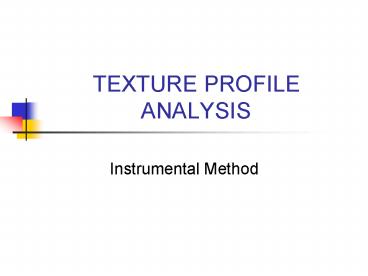TEXTURE PROFILE ANALYSIS - PowerPoint PPT Presentation
1 / 42
Title:
TEXTURE PROFILE ANALYSIS
Description:
Instrumental Method Down Up Down Up Force Time A1 A2 A3 Stringiness Resilience: A measurement of how the sample recovers from deformation. Ratio of the first UP ... – PowerPoint PPT presentation
Number of Views:3194
Avg rating:1.0/5.0
Title: TEXTURE PROFILE ANALYSIS
1
TEXTURE PROFILE ANALYSIS
- Instrumental Method
2
Texture Analyzers
- Module based instruments
- different load cells
- different probes/attachments/fixtures
- Crosshead moves at constant speed giving linear
deformation - Forces vary from 2N to 5kN
- Overhead load cell eliminates crumbs and force
due to sample weight
3
Texture Technologies
Shimadzu
Instron
Gardco
4
These carefully measure force and work to cause
some action on the food
-Compressive force shown directly vs time (speed
4 mm/s) -The work done on the sample up to 3mm is
5
Texture Profile Analysis
- Attempt to correlate instrumental measurements
with sensory descriptions - First developed by Friedman Szczesniak (1963) at
the General Foods Corporation General Foods
Texturometer - Modified by Malcolm Bourne for the Instron
- Bite-sized food compressed 2 times to simulate
chewing
6
- 1 cm3 (bite size pieces) compressed (and
decompressed) 2 times - Deformation typically 75-90 of height
- Follow force-time curve
7
(No Transcript)
8
(No Transcript)
9
(No Transcript)
10
(No Transcript)
11
(No Transcript)
12
(No Transcript)
13
(No Transcript)
14
(No Transcript)
15
(No Transcript)
16
(No Transcript)
17
(No Transcript)
18
Down
Down
Up
Up
Force
Time
19
Definitions
- Fractuability
- force required to produce first significant
break in the curve on the first bite. - Popular terms crumbly, crunchy, brittle
20
Second bite
First bite
Down
Up
Down
Up
Fracturability
Force
Time
21
- Hardness
- force exhibited in first bite at maximum
compression - Popular terms soft, firm, hard
22
Down
Up
Down
Up
Fracturability
Hardness
Force
Time
23
- Cohesiveness
- ratio of the positive force areas under first
and second compressions (A2/A1) Usually use only
areas under the compression part of curve (not
decompression), i.e. up to the dotted lines in
the figures.
24
Down
Up
Down
Up
Fracturability
Hardness
A2
Cohesiveness
A1
A1
Force
A2
Time
25
- Adhesiveness
- work to pull the plunger away from the sample
after the first compression (A3) - Popular terms sticky, tacky, gooey
26
Down
Up
Down
Up
Fracturability
Hardness
A1
Force
A2
A3
Adhesiveness A3
Time
27
- Springiness
- Distance over which the material recovers its
height between the end of the first bite and the
start of the second bite (BC) - Popular terms plastic, elastic
28
Down
Up
Down
Up
A1
Force
A2
A3
Springiness
Time
29
- Springiness sometimes defined differently, such
as by a ratio
30
Down
Up
Down
Up
A1
Force
A2
A3
L1
L2
Time
31
- Gumminess
- hardness X cohesiveness
- Popular terms short, mealy, pasty, gummy
32
- Chewiness
- gumminess X springiness
Dont report both gumminess and chewiness for the
same food!
33
A few terms have been recently added . . .
- Stringiness the distance that the product is
extended during decompression before separating
from the probe.
34
Down
Up
Down
Up
Stringiness
A1
Force
A2
A3
Time
35
- Resilience A measurement of how the sample
recovers from deformation. - Ratio of the first UP ( decompression) stroke to
the first DOWN ( compression) stroke
36
Down
Up
Down
Up
A5
A1
Force
A2
Time
37
- Initial Modulus Initial Stress/Initial Strain
- Initial Stress taken as mean force from 0.5 -1.5
secs and then dividing by the contact Area - Initial Strain calculated at the 1.5 second
point
38
Force
F1.5
1.5
Time (s)
39
GF Texture Profile Analyzer
- Similar to Instron but smaller scale and adapted
to food use only - Instron vs Texturometer
- Texturometer speed is sinusoidal, Instron speed
is constant - Instron has sharper peaks
- Instron force-time curve can be related to
force-distance
40
41
Studies by the General Foods Group showed good
correlations with sensory ratings. For
example, A. S. Szczesniak et al. Classification
of textural characteristics. J. Food
Sci. 28 385-389
42
- TPA has been used on a wide variety of foods
- Review by W. M. Breene (1975). Application of
texture profile analysis to instrumental food
texture evaluation. J. Texture Studies 6 53-82 - Do correlations with sensory evaluations exist
for all products?































